On re-reading an old magazine, I came across an article [1] based on the book written by General Sir James Shaw Kennedy in 1865 [2] in which he claimed that he advised a novel tactical layout for the British 3rd Division at Waterloo which was successfully adopted. He said he formed the battalions of the Division in oblongs, linked some together in pairs and formed them in "exchequer" fashion. This intrigued me to research how such oblongs could be formed.
The British drill regulations for the Napoleonic period were the "Rules and Regulations for the Formations, Field Exercise and Movements of His Majesty's Forces" dated 1st June 1792. These contain several methods of forming squares, depending upon whether the starting formation was a line or column.
These regulations are written in terms of a 3 rank line and only mention the 2 rank line as a possible variation, but the latter was already well established, despite official discouragement. [3] The stress on a 3 deep line throughout the regulations does however sometimes make it difficult to interpret actual practice and this is particularly so in the case of squares.
Throughout the 1792 regulations, almost all references to squares are in fact to "squares or oblongs". The context however makes it clear that this is in respect of forming the battalion as oblongs of 10 companies or squares of 8 companies. [4]
According to the 1792 regulations, squares formed from line by 3 centre companies standing still and the others falling back, creating an oblong with 3 companies on the front and rear faces and two on each side. This assumes the battalion forms line and square in 3 ranks, whereas throughout the Napoleonic period British troops formed in 2 ranks for line and 4 ranks for square. The 1825 regulations, which codified actual practice from the previous 33 years state that 2 rank line forms 4 rank square by half companies marching independently to their new position in the square, the leading half company forming the rear 2 ranks and the other half company forming the front 2 ranks (diagram 1).
The average British battalion had 600 rank and file (60 in each of 10 companies, ignoring Battalion headquarters staff and company supernumerary officers, sergeants and drummers). Such a square would have 45 files in the front and rear and 38 files on the sides (including the ends of the front and rear companies, who faced outwards). It is more square than oblong, and more proportionately square than it would be if formed in 3 ranks.
Squares formed from columns had a different layout to those formed from lines. Open Columns could be at Full Deploying Distance, Half Deploying Distance or Quarter Deploying Distance. A Column of Companies at Full Distance would have the equivalent of a complete company frontage between each successive company. If in Half or Quarter distance formation this would be proportionately reduced.
These same ratios are maintained in formations of double company width (the British Column of Grand Divisions) which means that if the formation is two companies wide, full distance is two companies depth or half distance is one company depth. A number of eminent military historians, authors and modern commentators have illustrations in their books or articles which get this wrong.
From Open Column of Companies a square was formed by the 2nd company closing on the 1st, thus making 4 ranks (the regulations actually say 6 ranks , but they assume the companies were in 3 ranks), the 3rd to 8th companies wheeling outwards by quarter companies which then double up to form 4 rank sides (again the regulations say 6 rank sides) and the 9th and 10th closing to form the rear of the square then facing outwards (diagram 2). The resultant formation was an oblong which (using the 600 man battalion example as above) would have a frontage of 30 files and sides of 53 files.
The regulations advise that the column should be at quarter distance if it is likely to confront cavalry since forming square can be achieved far more quickly from that formation. [5]
Squares could also be formed from column of two companies (Grand Division in British terminology). This formation is hardly mentioned in the 1792 regulations, which has led some commentators to incorrectly assume that the British did not use it. [6] It is important to realise that the regulations are written mainly in terms of columns of single companies, but the general rules could easily be adapted for columns formed from half companies or double companies. [7]
It is clear from tactical practice that most of the drill manoeuvres applicable to a single company column were possible for half companies or double companies, with minor modifications where necessary. Large British battalions frequently formed by two half battalion wings, in which case each wing manoeuvred as 10 half companies.
The use of double company frontage by columns waiting to deploy into line is specified within the regulations. [8] A square could easily be formed from such an open column of grand divisions by exactly the same principle as forming it on a single company frontage. The difference would be that the 1st and 2nd companies would stand still (thus forming the first two ranks of the front face of the square), the 3rd and 4th companies would close up (thus forming the rear ranks of the front face of the square), the 5th and 6th companies would wheel outwards by half companies (to form the sides of the square) and the remaining companies would close up and about turn to form the rear of the square (diagram 3). The resultant oblong (for a 600 man battalion) would have a frontage of 60 files and a depth of 23 files.
Battalions could form in close column, where the distance between successive companies was closed to only one pace. [9] In such a tight formation it was impossible to form a hollow square (since the centre companies could not wheel outwards to form the flanks. Forming square from close column was therefore achieved by the 2nd company closing on the first, and the 10th company closing on the 9th. All of the other companies detached men from their centre files who closed the gaps between each successive company. [10]
This created a "solid" square in which there was only a very small gap in the centre (diagram 4). The front and rear would be 4 ranks deep but the sides could be up to 10 ranks deep. In theory the formation would have been very fast (no more than 10 seconds for the front and rear ranks to form) but there would be some jostling as the men from the centre files struggled down the ranks to fill the gaps on the sides. For a 600 man battalion such a closed square would have a frontage of 30 files and a depth of 27 files, almost perfectly square.
Battalions could also join up to form linked formations [11] and the regulations cover such a composite formation forming square (invariably an oblong). [12] The regulations state that the battalions should be formed with their inner flank companies leading (ie the left battalion right in front and the right battalion left in front), exactly as both Shaw and Siborne describe the formation of the composite battalions of the 3rd Division.
The square was formed in a similar way to that from a column of companies. The leading companies from each battalion stood still, the next two closed up (forming a 4 rank front face to the square), the following six companies in each battalion wheeled outwards by half companies to form the 4 rank deep sides and the last two companies from each battalion closed up and about turned to form the rear face of the square (diagram 5). The resultant formation has a width of two companies frontage and sides comprising six half companies frontage. For a 600 man battalion this is a frontage of 60 files and a depth of 98 files.
Although there is no mention of such a formation in the 1792 regulations, it would have been theoretically possible for a composite column of two battalions to each be formed in Grand Division, thus giving a total frontage of 4 companies in column or square. On forming square only the centre two companies of each battalion would wheel outwards to form the sides. A square (oblong) formed from such a column of two battalions in Grand Division, each of 600 men, would have a frontage of 120 files and a depth of 38 files (diagram 6).
One final way in which a square could be formed was from a 4 deep line. This formation is not mentioned in the 1792 regulations but it was used by some battalions at Waterloo, apparently on the direct instructions of the Duke of Wellington.
There is no evidence of such a 4 deep line being used in the Peninsula, nor does it appear to have been used at Quatre Bras. It seems a odd throwback, given that the regulations of virtually every nation in the Napoleonic Wars specified a 3 deep line and the trend throughout the conflict was towards a 2 deep line. [13]
The 4 deep line seems to have mainly been used at Waterloo by the very large units of the Guards plus the 52nd and 71st Light Infantry. The stated reason for forming 4 deep was to have some protection against cavalry whilst remaining in line. [14] Two different methods are recorded of achieving this formation. The 2nd Battalion 1st Foot Guards "uncoiled" a 4 deep square [15] whilst the 52nd Light Infantry who had earlier split into two wings re-amalgamated them by bringing one wing up behind the other. [16]
The British troops at Waterloo thus had several methods of forming square. However only one of the three brigades of the 3rd Division was British, the others being the 2nd Kings German Legion Brigade and the 1st Hanoverian Brigade. Both the KGL and the newly reformed Hanoverian army used regulations very similar to the British, including a 2 deep line. The major variation was in the number of companies per battalion and this made a difference to the shape of squares or oblongs which they formed.
The original establishment of the KGL in 1803 was in 6 companies per battalion but recruiting proved good so in 1805 this was expanded to 8 and they remained on that organisation until 1812. During this period they had no Grenadier or Light companies but had 58 sharpshooters (including officers, NCOs and buglers), armed with Baker rifles, drawn from the other companies. [17]
In May 1812 the KGL adopted the standard British 10 company per battalion organisation, by forming a Grenadier Company and centralising the sharpshooters into a new Light Company. [18] Unlike British practice, the Light Company thus remained rifle armed.
KGL Officers were almost entirely Hanoverian but, cut off from their recruiting grounds, a number of "foreigners" were recruited, mainly from other German states. Promotions to sergeant seem to have been mainly from the original Hanoverian cadre. Following Napoleon's abdication in 1814 the KGL discharged its "foreigners" leaving its battalions with a full complement of Officers and Sergeants but a reduced number of soldiers. The plan to integrate the KGL into the new Hanoverian Army was suspended when Napoleon returned in March 1815.
The British Government wanted to boost KGL numbers by enlisting men from the newly formed Hanoverian Landwehr, who had exactly the reverse problem of plenty of men but a shortage of officers and sergeants, which led to their organisation as 4 large companies per battalion. The Hanoverian government vetoed this and the alternative plan was put into effect by which the KGL battalions were reduced to 6 companies with the surplus officers and sergeants transferred to the Hanoverian Landwehr. [19]
The 1st Hanoverian Brigade comprised regular Hanoverian battalions, not Landwehr. These battalions had been formed in 1813 as the northern part of Hanover became free of French control and they served as part of the Anglo/Hanoverian/Russian force under General Wallmoden in the campaign in Northern Germany around Hamburg in that year. They were organised as eight companies per battalion, plus sharpshooters, exactly the same as the King's German Legion in the period 1805 to 1812. [20]
Returning to Shaw's original statement, regarding the formation of the 3rd Division, and comparing this with what was possible, a rather different pattern emerges. Shaw stated that :
Surprisingly the Divisional layout, as stated by Shaw and Siborne, was not in accordance with these principles as the weakest KGL battalions were formed singly, not in pairs (Map A at end of article).
Shaw's description of the battalion formation seems to state that, if formed as single battalions, they formed square from a Column of Grand Divisions or if in linked pairs, from a pair of Columns of Companies. As demonstrated above, both of these are standard drill manoeuvres from the 1792 regulations. The reference to being formed with 4 companies in front is confusing.
A single battalion would have 2 companies forming the first two ranks and 2 forming the 3rd and 4th ranks. It would only be possible to have 4 companies side by side in the front face if the square was formed from a 4 deep line, in which case each company would have a half company frontage (the other half forming the 3rd and 4th ranks). Whichever of these ways a battalion is formed it will have the same shape (for a 600 man battalion, a frontage of 60 files and depth of 23 files).
The method Shaw describes of forming squares from pairs of battalions is identical to that in Section 207 of the 1792 regulations, published 16 years before he was born. He states the pairs of battalions were each in Column of Companies (as per the regulations) but that the fronts of the oblongs were formed by 4 companies. A pair of Battalions each in Column of Companies forms square with a frontage of 2 companies (although the 3rd and 4th ranks will be composed of 2 more). If the Battalions were each in Column of Grand Division then the face could have 4 companies frontage, with sides equivalent to a single company.
The time to form square from line and various types of column is in table B. This assumes that each company has 60 rank and file in two ranks (with the regulation 22 inches per man opening out to 24 inches per man in practice). The resultant company frontage of 60 feet is equivalent to 24 paces. The time taken is that for the furthest company (normally the Light Company) to march to its position in the square. The 1792 Regulations state that this should be at the double of 120 paces (each of 30 inches) per minute and this has been used in the calculation below. In practice the cavalry threat may well have made companies move faster than the regulation 120 paces per minute. [21]
Linked Bttns cannot form square from quarter distance of companies (no space for sides to wheel). Shaw's reference to forming on "two centre companies" being quicker than forming on a flank company is also confusing. For any given deploying distance, it is actually quicker to form square from a column of single companies because the rear company has less distance to double forward. Shaw appears to be referring to the possibility to halve the optimum deploying distance if formed as a column of grand divisions rather than a column of companies, and this obviously makes a saving in time to form square. Nevertheless it is still faster to form hollow square from a column of single companies at quarter distance than in any other method and this is why the 1792 regulations stated this should be used whenever a cavalry threat was present.
Shaw's description of the way in which such formations formed is only really relevant to the one British brigade of the Division (a common problem with British writers of the era, who rather dismissed, or failed to consider, matters concerning their allies). The KGL battalions only had 6 companies during the Waterloo campaign and since they were deployed singly could only have formed square (oblong) on a single company frontage (or two half companies) with a half company depth. Hanoverian regular battalions with 8 companies forming square from any type of column had to be in a square, not oblong, formation regardless of whether they formed by single battalions or pairs (Diagram 7). [22]
Shaw states that the 3rd Division was arraigned "exchequer" fashion. This is mentioned in the 1792 regulations [23] and was well known as a sensible layout, because it enabled troops to provide mutual support to each other. [24] Shaw stated "formation of squares in exchequer was used by the Austrians at Aspern in 1809 but no such formation was known to the British Army or in England". This is clearly nonsense as is proved by the initial layout of the Guards Division at Waterloo, which Shaw does not claim credit for. [25]
The 1825 regulations, published 40 years before Shaw wrote his book, state that when several battalions form square they should do so in an echelon formation. [26] Since these regulations were a consolidation of tactical practice during the Napoleonic Wars, it seems unlikely that such advice would have been based solely on Shaw's "innovation".
So what really happened regarding the layout of the 3rd Division at Waterloo? Shaw, as a 27 year old Staff Officer, gave Wellington his views, which were dismissed with a curt "Form in the usual way". Wellington was well known for such abrupt comments and with other things on his mind, like facing Napoleon for the first time, probably thought that this was not the moment to experiment with tactical layouts. Shaw apparently then persuaded his Divisional Commander, Lieutenant General Sir Charles Alten, to adopt his suggestions.
Shaw was a competent staff officer, [27] but it is unlikely that General Alten, taking into consideration his background and personality, [28] would have agreed to anything unusual. What is likely is that General Alten took more time than Wellington had to listen to Shaw, decided that there was really nothing controversial in Shaw's proposals (after all everything he proposed was in the drill regulations), and therefore allowed it. If it had been as revolutionary as Shaw claimed, General Alten would never have agreed it, in view of Wellington's order to "form in the usual way".
Shaw, like many Napoleonic diarists, wrote his notes many years after the battle and it would seem that he rather overstated the degree of original thought in his actions. This seems to have been common in the period since many of the best known and readable personal accounts from the wars suffer from the same failing. [29] Shaw also wrote a plan for the defence of Canada but arrogantly believed it was not necessary to visit the country.
An important question however is, regardless of how original such formations were, was it successful. Certainly formation of squares from columns was faster than from lines, but that was well known and perfectly standard practice. Forming of multi-battalion formations on the other hand was not generally successful during the Napoleonic wars. [30] The British, KGL and Hanoverian battalions of the 3rd Division suffered higher casualties than the remainder of the army (even more than the Guards at Hougoumont or Picton's Division on the left flank). [31]
These seem particularly heavy for those battalions who formed composite squares. [32] Shaw himself states "Omteda's brigade was nearly annihilated, and Kielmansegge's so thinned, that these two brigades could not hold their position". It is difficult to draw conclusions from this because it may merely be a reflection that the fighting was heaviest on their sector, but all of the general evidence from the Napoleonic wars points towards an optimum battalion size of between 500 to 800 men. Multi-battalion formations were inflexible, took longer to manoeuvre, and suffered proportionately larger casualties from Artillery and Musketry fire. The 1825 Regulations, based on wartime experience, specifically advise against forming multi-battalion squares. [33]
The true tactical variation at Waterloo was the use of the 4 deep line on Wellington's personal orders. This was not used by the 3rd Division. It seems that "Shaw's squares" were not especially tactically innovative, nor were they particularly successful.
[1] Shaw's Squares by Philip Haythornthwaite in Empires, Eagles & Lions Volume 2 Number 1.
Map A:

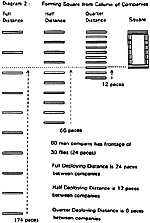
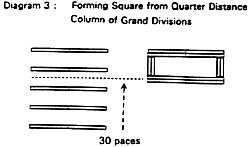
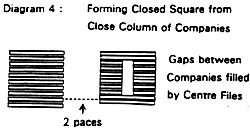
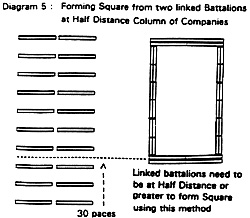
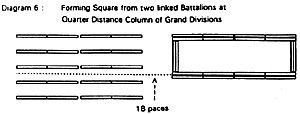
"strong battalions formed each an oblong on the two centre companies, and when the battalions were weak, two were joined, the right hand battalion of the two forming left in front, and the left hand battalion right in front, each in column of companies. The fronts of the oblongs were formed by four companies; the rear faces of the oblongs were formed by the outward wheel of subdivisions. It will be observed that, when a battalion forms oblong in this manner upon the two centre companies, the formation is made in less than half the time in which it would form square on a flank company".
Time Taken to Form Square
(from)Single battalion Pair of Linked Battalions
March Distance
(Paces)March Time
(seconds)Total Time
(seconds)March Distance
(Paces)March Time
(seconds)Total Time
(seconds)Line 144 72 92
480 240 260 Full Distance
Column of Companies174 87 102
138 69 84 Half Distance
Column of Companies66 33 48
30 15 30 Quarter Distance
Column of Companies12 6 21
Not Possible Close Column
of Companies2 1 16
2 1 16 Full Distance
Column of Grand Divisions174 87 102
162 81 96 Half Distance
Column of Grand Divisions78 39 54
66 33 48 Quarter Distance
Column of Grand Divisions30 15 30
18 9 24 Close Column
of Grand Divisions2 1 16
2 1 16
Notes: Total time includes allowance for orders, turns, etc. This is 20 seconds for line (all companies make 2 turns) and 15 seconds for column (rear companies make 1 turn).

Notes:
[2] Notes on the Battle of Waterloo by Sir James Shaw Kennedy KCB.
[3] Section 77 of the 1792 regulations states " The fundamental order of the infantry, ...is in three ranks;- The formation in two ranks is to be regarded as an occasional exception...- But from the present low establishment of our battalions, they are during the time of peace permitted, in order to give more extent to their front in their operations, to continue to form and use it, in many of their movements and firings, at the same time not omitting to practice them in three ranks".
[4] Section 178 of the 1792 regulations describes a 10 company "oblong" and then qualifies this with the statement "the square may be a perfect one, if it is composed of the eight battalion companies only; the grenadier and light company being in the rear".
[5] Section 178.10 of the 1792 regulations covers forming square from Open Column. It recommends that the column be at quarter distance if there is a cavalry threat, clearly because this is the fastest method of forming hollow square.
[6] Section 147 of the 1792 regulations covers close column of companies forming column of two companies (Grand Division). The "Letters of Private Wheeler" (Page 87) states "we broke into open column of divisions... The fire at length became so furious that it were expedient to form grand division, thus leaving an interval of double the space for their shot to pass through".
[7] Sections 87 to 90 of the 1792 regulations deal with decreasing column frontage from company to half company and vice versa. In "Wellington in India" (page 291) Jac Weller states that the Anglo-Indian armies used half company columns as their normal formation (presumably due to the difficulty of manoeuvring on a wider front in the relatively dense Indian terrain).
[8] Note 2 (on Page 175) of the 1792 regulations states "The close column will generally be formed of companies for the purpose of movement; but when it is halted, and is to deploy into line, it will stand two companies in front, and five in depth".
[9] Page 175 of the 1792 regulations gives the general rules for forming close columns.
[10] Section 189 of the 1792 regulations describes forming square from close column of companies.
[11] Paragraphs 4 - 5 to Section 187 of the 1792 regulations cover two battalions linking as a column of two companies frontage.
[12] Section 207 of the 1792 regulations describes when the square or oblong is composed of more than one battalion.
[13] The British originally formed 2 deep lines to cover larger frontages. The 1792 regulations warn that the 3rd rank is necessary to replace casualties in the front ranks. This 18th century view of the need to preserve the integrity of the battle line was superseded by more fluid tactics and all Napoleonic Armies accepted shrinkage of battalion frontages. Prussians (and Austrians to some degree) used the 3rd rank of their line battalions as skirmishers. In 1805 Ney advocated the use of 2 ranks but the French did not experiment with it until 1814, again as an attempt to spread the frontage of understrength battalions.
[14] Waterloo Letters 105 : Major-General P Maitland (commanding 1st Guards Brigade) states "About 7 o'clock pm, the Duke of Wellington, aware of the Enemy's preparation for a new attack, desired me to form the 1st Brigade of Guards in line four files deep, His Grace expecting that the French Cavalry would take part in the affair".
[15] Waterloo Letters 109 : Captain H W Powell, 1st Foot Guards states "The Duke of Wellington ... ordered the 1st Brigade of Guards to take ground to its left and form line 4 deep, which poor Frank D'Oyley did by wheeling up the sides of the square, putting the Grenadiers and my company (1st Battalion Company) in the centre of our line. What would Dundas have said !!". It seems this square was formed from a column, with the Grenadier and 1st Company on the front face. Line formed by wheeling up the sides places the Grenadier and 1st Company in the centre, a most unorthodox layout compared to the "Dundas" 1792 Regulations.
[16] Waterloo Letters 124 : Lieutenant Gawler, 52nd Regiment states "the 52nd at first formed quarter distance columns of wings [half battalions] and afterwards deployed into two lines, the left wing in rear, but closed up to one pace from the right wing. The other Regiments of the Brigade, I have every reason to believe, made precisely the same formation".
[17] "Nec Aspera Terrent" [History of the Hanoverian Army] by Friedrich Schirmer (Vol 2, Page 8).
[18] "Des Königs Deutsche Legion" by Bernhard von Poten (Page 7).
[19] History of the King's German Legion by N L Beamish (Page 323). "Geschichte der Königlich Deutschen Legion" by Bernhard Schwertseger (Page 303) quotes the order (dated April 1815) listing the 91 officers (by name) and 104 sergeants to be transferred to the 16 Landwehr battalions serving with the Field army. This injection of six capable officers and six experienced sergeants per Landwehr battalion undoubtedly contributed greatly to their steady performance during the Waterloo campaign. In common with the system used to restructure the Portuguese army in 1808, many of those transferred received a step in promotion.
[20] "Nec Aspera Terrent" by Friedrich Schirmer (Volume 2, Page 38).
[21] Section 17 of the 1825 regulations changes Double March to 150 paces (each of 36 inches) per minute. The degree to which this increase in doubling speed was used during the Napoleonic wars is not clear but several reminiscences report being exhausted by doubling and this is unlikely at 120 paces per minute (the modern British Army standard marching pace).
[22] A Hanoverian battalion formed square from Column of Companies with a one company frontage, and a second one forming the 3rd and 4th ranks of the front face. The sides had a frontage of two half companies, with two more half companies forming their 3rd and 4th ranks. If square was formed from a pair of linked battalions the number of companies or half companies on each face would be doubled but the proportions would remain perfectly square. The only way which an oblong could be formed was by 3 companies, each on a half company frontage (with the other half forming the 3rd and 4th ranks) forming the front face and one company, again on half company frontage, forming the sides. Such a layout is only possible when forming from line, not column.
[23] Page 353 of the 1792 Regulations covers "chequered retreat of the line".
[24] The Prussians particularly used this layout and their 1812 Exerzir-Reglement contains a diagram of it.
[25] Siborne, in his History of the Waterloo Campaign (Page 210) states that the initial disposition of the Guards Division "was such, that the four battalions of the division were placed en échiquier".
[26] Paragraph 5 to Section 79 of the 1825 regulations states "When battalion squares are to be formed either from line or column, composed of several battalions; the line, or the column in mass, or the line of contiguous columns, must be previously thrown into echelon of battalions; or so placed by the wheel of the divisions on which each square is formed, that the adjoining angles of each square shall be clear, in order to create a mutual defence from the faces, which will then flank each other at right angles".
[27] Shaw was a member of the 43rd Light Infantry, part of the famous Light Division in the Peninsula. The Regiment had a reputation for "flair" as described by one of their contemporary officers : "The 43rd were a gay set, the dandies of the army, the great encouragers of dramatic performances, dinner parties, and balls". The officers were nevertheless extremely professional in their duties and Shaw had served as ADC to Major General Robert Crauford, who did not suffer fools gladly.
[28] General Alten commanded the 1st Battalion KGL Light Infantry on its formation. In 1811, promoted to Major General he commanded a brigade comprising the 1st and 2nd Light Battalions KGL and the Brunswick Oels Jägers. In 1812, after Crauford's death, General Alten took over command of the Light Division for the remainder of the Peninsular War. He was described as a capable commander who would comply with Wellington's wishes (Crauford's Light Division by Ian Fletcher page 205).
[29] Marbot, Mercer and Kincaid are all superbly readable accounts but in all cases the authors are prone to self-aggrandisement.
[30] Macdonald's square at Wagram and d'Erlon's columns at Waterloo were multi-battalion formations suffering massive casualties.
[31] Based on Siborne's figures the 3rd Division suffered 31% casualties, the highest rate of any Division, compared to the 1st (Guards) Division's 24% and the 5th (Picton's) Division's 19%.
[32] "Das Celler Soldatenbuch" by Friedrich Schirmer contains a chapter on the Bremen and Verden Field Battalions at Waterloo. These battalions formed one of the 3rd Division's composite squares and started the campaign with 8 companies per battalion. Schirmer states that at the end of Waterloo "Only 4 weak companies could be made from the 2 battalions".
[33] Section 142 (paragraph 23) of the 1825 Regulations states "squares consisting of several battalions, can seldom be necessary; for the time taken up in the formation is inconsistent with .... defence against the sudden attack of the enemy's cavalry".
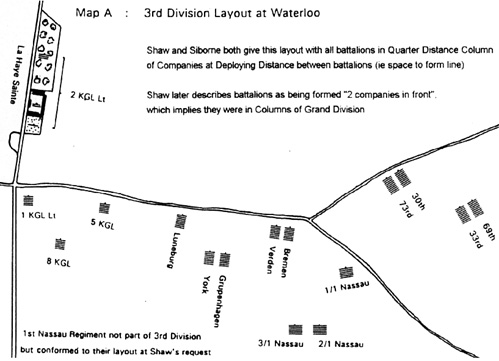
Back to Age of Napoleon No. 23 Table of Contents
Back to Age of Napoleon List of Issues
Back to MagWeb Master List of Magazines
© Copyright 1997 by Partizan Press.
This article appears in MagWeb (Magazine Web) on the Internet World Wide Web.
Other military history articles and gaming articles are available at http://www.magweb.com